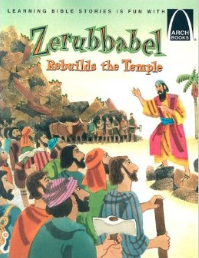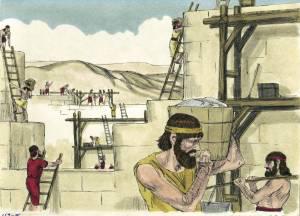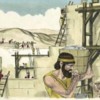Return from Exile - Lesson Set

Bible Reference:
Books of Ezra and Nehemiah
Key Verse:
"Rejoice always, pray without ceasing, give thanks in all circumstances; for this is the will of God in Christ Jesus for you." I Thessalonians 5: 16-18 (NRSV)
Workshops Offered (with brief description
- Art: The students will make brick bookends as they reflect on the “building” that God does in their lives.
- Games: The students will learn about the story as they move through a life-size game board.
- Music: The students will practice for singing in church (no lesson provided for this)
- Video: The students will watch and discuss What’s in the Bible: Exile and Return. The PreK students will learn more about prayer as they watch Prayer Bear.
Suggested Story Books
- Jesus Loves Me Story Bible, p. 229
- Zerubbabel Rebuilds the Temple (Arch Books)
- Nehemiah Builds the Wall (http://www.biblewise.com/kids/.../nehemiah-builds.php)
Important Note for All Teachers on Telling the Bible Story:
Every station (workshop) includes the Bible story, as one of our main goals is for the children to learn what is in the Bible! All children old enough to read should find the story in the Bible (there are Bibles in each classroom). There are different ways to tell the Bible story: teacher reads the story directly from the Bible as students follow along; students read several verses at a time (don’t force anyone to read); teacher reads the story from a Children’s Bible or a Bible storybook (make sure that the children know this is a true Bible story and not a make-believe story); use a flannelboard to tell the story (we have a wonderful, detailed set).
Later in the rotation, after the students have heard the story before, you could use some of these ideas to tell the story (make sure they are telling it correctly): You start the story and have them finish; go around in a circle and have each student add on a part of the story; tell the story with mistakes and have them correct you; use a picture book—instead of reading the story to them, show them the pictures and have them tell you the story; ask a series of questions about the story as a way of having them tell the story (Who are the main characters? Where does story happen? What happens first? ….Continue to ask leading questions until the story is done.)
** Part of telling the story is asking questions. After you ask a question, wait. The silence may seem painfully endless, but often a moment is required for the students to think and collect their thoughts. Another benefit of waiting for the answer is that everyone has time to think about an answer, instead of just listening to the quickest person’s answer.
Bible Background Information
Historical Setting
God’s people were united in one kingdom during the reigns of King Saul, King David, and King Solomon. The later years of Solomon’s reign were troubled ones, as he began to turn away from the Lord. He married many foreign wives and started to worship their idols. After his death, the kingdom was divided into two: the Northern Kingdom of Israel and the Southern Kingdom of Judah (whose territory included the city of Jerusalem). Thus began a cycle of evil kings and prophets who tolerated or even supported idol worship, yet there were also faithful kings and prophets who called the people back to the true faith.
The two kingdoms eventually suffered the consequences of their disobedience. The Northern Kingdom of Israel was captured and destroyed by the Assyrian empire in 622 B.C. and taken into captivity. The Southern Kingdom of Judah was assailed by Nebuchadnezzar, king of Babylon. There were several instances of deportations before Jerusalem was destroyed in 587 B.C. Daniel (of the Lions’ Den fame) was one of those deported in 605 B.C.
Moses had warned the people of this possibility many, many years ago in Leviticus 26 when he talked to the people about the reward for obedience and the punishment for disobedience: “If in spite of this you still do not listen to Me but continue to be hostile toward Me, then in my anger I will be hostile toward you…” (vv. 27-28). The punishment would include being scattered among the nations and the land laid waste and the cities to lie in ruins (v. 33). God goes on to say (through Moses) that “if they will confess their sins….I will remember my covenant” (vv. 40-41). The prophet Jeremiah declared to the people of Judah that God would bring Nebuchadnezzar against their land and the land would become desolate and that they would undergo 70 years of captivity (Jer. 25: 8-11). So, the punishment would not last forever. Isaiah, in a prophecy directed to the future exiles, tells them that Jerusalem shall be inhabited and that the towns of Judah will be rebuilt out of their ruins. Isaiah also speaks of a man called Cyrus, whom God will use: “he [Cyrus] will say of Jerusalem, ‘Let it be rebuilt,’ and of the temple, ‘Let its foundations be laid’” (v. 28).
These prophecies begin to be fulfilled around the year of 540 B.C. The king of Persia, a man named Cyrus(!), defeats the Babylonians. The Lord moves the heart of Cyrus to begin the process of returning the exiles to their home. The return from exile is actually a series of three returns, with three different leaders. This series of stories is told in the books of Ezra and Nehemiah (the oldest manuscripts treated these as one book).
Zerubbabel
God moved the heart of King Cyrus to make a proclamation that the exiles could return to Jerusalem and rebuild the temple of the Lord. Around 50,000 people made the journey to Jerusalem. Many of the exiles opted not to make the long and difficult journey back to Jerusalem, among them the parents of Esther (who would become the Queen of the Persian king Xerxes). They were given gifts by their neighbors, and the items that had been stolen from the temple 70 years earlier by Nebuchadnezzar were returned to them. Their leaders included Sheshbazzar, Jeshua, and Zerubbabel (a grandson of Jehoiachin, the King of Judah, who had been carried off to Babylon).
Upon their arrival, they rebuilt the altar so that they could offer sacrifices to the Lord. Then they laid the foundation for the new temple to be built. Work on the new temple faltered because the people became busy working on their own homes and because of intimidation. The neighboring Samaritans soon began to oppose the building of the temple. They lodged complaints via letters to the new king of Persia, implying possible rebellion and threats to the king from the inhabitants of Judah. The king sent a letter, stating that the work should stop. And so it did for 15-20 years.
The prophets Haggai and Zechariah began encouraging the people to work, not on their own homes, but on the house of the Lord. Work resumed and again the neighbors complained, this time to King Darius. There was a different outcome this time. Darius rediscovered the original decree from King Cyrus and ordered that the rebuilding continue. The temple was completed, the dedication was celebrated with great joy, and the people celebrated Passover.
Ezra
The next phase in the return of the exiles began about 60 years later. Ezra (whose name means helper) was a priest directly descended from the first chief priest Aaron (brother of Moses). The new king of Persia, Artaxerxes, gave him the task of going to Jerusalem and teaching the people about the laws of God. Zerubbabel had been in charge of building the physical temple; Ezra was tasked with rebuilding the spiritual foundations of the people.
Ezra assembled another smaller group of exiles. He was also given gifts (worth millions of dollars today) to bring to the house of the Lord. These riches would be tempting bait for robbers. Ezra “was ashamed to ask the king for soldiers and horsemen to protect us from enemies on the road, because we had told the king, ‘The gracious hand of our God is on everyone who looks to him, but his great anger is against all who forsake him.’ So we fasted and petitioned our God about this…” (Ezra 8: 22-23). The people and the gifts arrived safely.
Shortly after his arrival, Ezra learns that some of the people and even the priests have been marrying pagans from neighboring lands. This was a serious problem because it could lead to people turning from God to worship pagan idols (something that had happened in the past). Ezra demonstrated the seriousness of this offense by falling to his knees, weeping and tearing his clothing, and pulling out his hair. He prayed to God. The people observed this and they, too, wept. They also confessed their sins. The unlawful marriages were dissolved. Ezra helped to spark a spiritual revival.
Nehemiah
Nehemiah (whose name means “comfort of Yahweh" entered the picture thirteen years later. He was not of kingly descent (like Zerubbabel) or priestly descent (like Ezra). He was an ordinary man who held a high position in the court of King Artaxerxes of Persia. He was the cupbearer—he chose and tasted the king’s wine to make sure that it was not poisoned. Even though it doesn’t seem like a very prestigious job, it actually was very important. The king had to have the utmost confidence in him. Nehemiah had heard from his brother that the city walls of Jerusalem remained in ruins, which would leave the city defenseless against its enemies. He immediately wept and prayed to God. The king asked him why he was so sad. Again, Nehemiah prayed before answering and then asked the king’s permission to journey to Jerusalem to rebuild the walls. The king appointed him governor and sent him to Jerusalem with another group of returning exiles and an armed escort.
Nehemiah toured the walls late one night; the damage was so bad that some of the roads were impassable. He spoke with the Jewish officials and told them how the gracious hand of God had been upon him. Work on rebuilding the walls soon commenced. All of the people worked together, including groups such as the high priest and goldsmiths and women; often working in the vicinity of where they lived. Just like with the temple, opposition arose from the neighbors. It started with ridicule, which had no effect. Then they plotted to fight against Jerusalem. In response, the people prayed and posted guards. Half worked and half guarded. Those who worked had materials in one hand and weapons in the other.
Fear of attack from the outside wasn’t the only problem. Internal financial problems were cropping up. Nehemiah was angry that some rich people were taking advantage of their fellow Jews by charging exorbitant rates of interest and causing them to sell their property and subject their children to slavery. Nehemiah demanded that they give the money back, which they did.
Rebuilding continued. The walls (which scholars estimated to be about 2 miles around) were completed in just 52 days. Under Nehemiah’s leadership, the people overcame opposition and worked together to achieve their goal. Surrounding nations were afraid because they realized that this could only have been done with the help of God.
Then all of the people gathered in one of the squares of the city. Ezra stood on a high wooden platform and read from the Book of the Law. The people stood and listened attentively from daybreak until noon! The Levites explained things so that the people could understand what was being read. The people wept as they listened. Ezra and Nehemiah instructed them not to grieve but to celebrate because they now understood the words that had been made known to them. Later that month, they confessed their sins and remembered all that God had done for them. The people of God were restored both religiously and politically to their homeland.
Key Ideas
- Rebuilding is covered on many levels. First, there is the physical rebuilding of the temple and the city walls. Then there is the spiritual rebuilding of God’s people after Ezra re-acquaints them with God’s law. God continues to “rebuild” us. First, when we were washed in the waters of baptism and became children of God. He continues to renew us as the Holy Spirit works in the hearts of all believers.
- The destruction of Jerusalem may have seemed like the end of God’s promises and led to doubts, but God remembered and restored His people. They were still God’s people and He had not forgotten them. God keeps His promises. Whether the struggle is physical, mental, or spiritual—God is at our side. God never leaves or forsakes us.
- God moved the hearts of secular rulers (Cyrus, Darius, and Artaxerxes) to allow, even encourage and help, the Jewish people to return home. He used them to fulfill His promises to His chosen people. God guides history for the sake of His people.
- God uses all kinds of people in all types of places doing all sorts of work. Do you feel you must be “in ministry” in order to serve God? He is not limited by your vocation. In fact, God has placed you where you are for a purpose.
- Nehemiah’s life a wonderful example of leadership.
- There are a number of examples of prayer in these two books. It is important to note that Nehemiah went directly to the Lord in prayer when he was faced with challenging circumstances. He certainly did not consider prayer to be a measure of last resort. As our Bible verse says, pray without ceasing.
References:
- Burton, Julie. Nehemiah—Bible Background. https://www.rotation.org/topic...2#295011598215966342
- Chaignot, Mary Jane. “Nehemiah”. http://www.biblewise.com/bible...racters/nehemiah.php
- Concordia Self-Study Bible (NIV). Concordia Publishing House. 1984
- “Ezra”. Insight for Living. https://www.insight.org/resour...istorical-books/ezra
- Halley, Henry. Halley’s Bible Handbook. Regency Reference Library. 1965.
- Lutheran Study Bible (ESV). Concordia Publishing House. 2009.
- “Nehemiah”. Insight for Living. https://www.insight.org/resour...rical-books/nehemiah
- Our Life in Christ. Bible Background Notes. Concordia Publishing House.
A set written by Cathy Walz 2014.
Images in this post are in the Public Domain, via Wikimedia Commons: The painting "Ezra Reads the Law to the People is by Gustave DorÉ. (1866)
A representative of Rotation.org reformatted this post to improve readability.
Printed from https://www.rotation.org


 Rebuilding the Walls
Rebuilding the Walls




